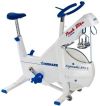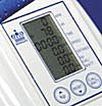Wingate anaerobic test
This test is used to determine peak anaerobic power. It was developed at the Wingate Institute in Israel, during 1970s. It is performed on a cycle ergo-meter. This test requires the individual to pedal a mechanically braked bicycle ergo-meter at an all out pace with no resistance (see figure 3). The maximum performance is 80 – 90%. Upon completion of the tests individuals should pedal against a low resistance in a cool-down phase. The test is based on the idea that anaerobic performance is not central (heart, lung) but it depends on peripheral and local features. It examines the total amount of work accomplished over certain second bouts. In these workouts the factor that defines performance is not the oxygen supply system but the local metabolism. It converts chemical energy into mechanical energy (Mészáros, 1990). It shows the mechanical energy of musculature within a short period of time. It is used for measuring performance and evaluating the degree of development.
Protocol
- Data of individuals’ body-mass should be entered a computer connected to a bicycle.
- Then resistance is calculated by a software. The appropriate weight (75g/ body-mass kg) should be fixed above the fly wheel of a bicycle with the help of a magnetic lifter.
- Then individuals gradually wind the bike until it reaches 90 rpm shown own a digital display. The weight drops on the fly wheel and from this time on maximum power should be used for 30 second time span.
From these data the maximum anaerobic capacity can be calculated which is characterised with two factors, that is, peak anaerobic power and average performance.
Peak anaerobic power represents the highest mechanical power generated during 5 second interval of the test. These data will show alactacid and phosphate energy supply.
Average performance: it is calculated from the average of current performance based on the speed measured for 30 seconds.
Data are recorded and analysed by a computer.


